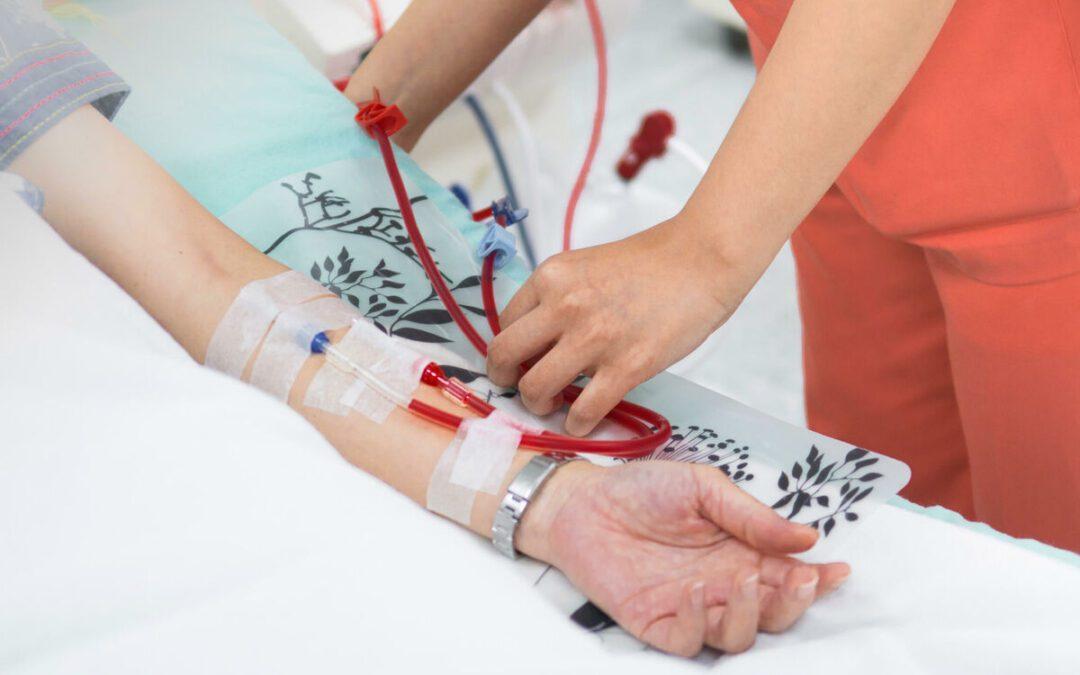For many facing kidney failure, dialysis is a crucial support system, though it’s not without its hazards. One unsettling truth many wonder about is can a person die during dialysis. In this piece, we explore the risks involved with dialysis treatments and their potential to lead to dire outcomes, an issue that weighs heavily on many minds. We explore factors contributing to mortality rates among dialysis patients from cardiac issues to procedural errors, and preventive measures designed to make dialysis safer.
Moreover, you’ll delve into the latest studies on patient results and encounter genuine narratives that vividly illustrate these figures, enhancing your comprehension. By equipping you with the necessary insights, we aspire to empower your journey through the intricate world of dialysis; also you can contact Drbismah, fostering a more profound sense of assurance.
Understanding the Risks of can a person die during dialysis
While dialysis often stands as a beacon of hope, it’s shadowed by various risks that cannot be overlooked. Knowing what can go wrong helps patients and caregivers be more vigilant.
@kidneyhealthmd Improve kidney function quickly with natural personalized plan Visit https://linktr.ee/drbismah to learn more about how to improve your kidney health. #KidneyHealth #MaximizeKidneyHealth #Inflammation #ChronicKidneyDisease #FunctionalMedicine #HealthyDiet #HealthyLifestyle #Drbismah #KidneyCare #PersonalizedPlan #HolisticApproach #HolisticHealing #PersonalizedTreatment #NaturalRemedies #KidneyDisease #DrIrfan #Detoxification #md #kidneydoctor #Kidneydiet ♬ original sound – Kidney and Holistic MD
The Reality of Sudden Deaths in Dialysis
Sadly, dialysis sessions aren’t without risks. Research indicates that as many as 25% of individuals undergoing hemodialysis could encounter an unexpected demise, frequently within a half-day following their treatment. The gravity of these occurrences highlights the critical need to delve into the causes behind such devastating outcomes. The reasons behind sudden deaths range from heart issues exacerbated by treatment to complications arising from how dialysis is performed.
Cardiovascular disease stands as a titan among causes, making cardiac arrhythmias during or after treatments not just possible but alarmingly common. During dialysis, the dangers of air embolism and catheter-related issues play a substantial role in increasing the death toll. Understand the all fector of how long can a person live on dialysis?
Preventative Measures to Achieve Safe Dialysis Experiences
To mitigate these hazards, healthcare workers implement various tactics to enhance the well-being of individuals undergoing kidney cleansing treatments. Innovations like the Transonic Hemodialyzer Monitor, which aids in detecting potential problems early on, have proven invaluable.
Maintaining a strict balance regarding fluid management and electrolytes while keeping an eye on blood pressure levels are all critical steps toward minimizing risk factors associated with renal dialyzes such as etiology-induced complications stemming from procedural errors or equipment failure.
Factors Leading to Mortality During Dialysis
Cardiac Issues and Their Impact
Dialysis may provide lifesaving help to those experiencing kidney failure; however, its risks should not be underestimated. Chief among these are cardiac issues, which significantly increase the danger during dialysis sessions. In individuals receiving this therapy, conditions such as heart disease and failure are common complications. Shockingly, causes such as cardiac arrhythmias can lead directly to fatalities.
Grasping the nuanced relationship between dialysis and cardiac wellness is essential, albeit intricate. For instance, fluctuations in fluid levels and electrolytes during the process can strain an already weakened heart, leading to adverse events including sudden deaths.
Procedural Complications as Fatal Risks
Beyond the shadow cast by cardiovascular complications lies another threat: procedural errors or issues with dialysis equipment itself. Deaths occur due to a variety of reasons ranging from air embolism – tiny air bubbles entering blood circulation – to complications arising from catheter insertion into access sites on a patient’s body.
To combat these dangers, can a person die during dialysis? Innovations such as the Transonic Hemodialyzer Monitor, designed to spot early indicators of life-threatening complications and thus allow for swift corrective action, have emerged.
In summing up this grave yet vital topic, we touch upon both natural occurrences within one’s body and technical glitches outside it – all converging at a point where vigilance becomes synonymous with survival for hemodialysis patients.
Preventive Measures to Enhance Safe Dialysis Experiences
Dialysis treatment can save lives, yet its risks must also be understood and minimized to provide individuals with safe experiences during dialysis treatment. Acknowledging and mitigating such hazards is paramount to safeguard individuals starting dialysis treatments. Here, we focus on the tools and strategies that make a difference.
Monitoring Tools That Save Lives
Advanced devices, such as the Transonic Hemodialyzer Monitor, have revolutionized patient care by significantly reducing the incidence of unexpected fatalities in those undergoing hemodialysis. By managing fluid balance, electrolytes, and blood pressure more accurately, this tool helps avoid complications that could lead to fatal outcomes. Managing these factors effectively minimizes risk significantly.
One startling statistic highlights why such innovations are vital: up to one in four hemodialysis patients may die suddenly, often within 12 hours after their session ends. Underscoring the importance of vigilant observation throughout kidney cleansing procedures is paramount.
Explore our detailed guide here to learn more about how technology is revolutionizing patient care during dialysis treatments. It’s packed with insights into how equipment like the Transonic monitor paves the way toward safer dialysis experiences by offering real-time data analysis critical for patient health management.
Research Insights on Dialysis Patient Mortality
Dialysis treatments offer lifesaving support to those living with end-stage kidney disease; however, recent research from Veterans Affairs Boston Healthcare System sheds light on its dark side by analyzing mortality rates among dialysis patients undergoing treatments.
The Importance of Comprehensive Data Analysis
Aiming to unravel the mystery behind mortality rates in hemodialysis, scholars meticulously examined records, lab results, and autopsy reports. What they found was both revealing and concerning: up to one in four hemodialysis patients may die suddenly, often within 12 hours after their session. This alarming figure underscores the urgent need to explore every element involved thoroughly.
This analysis isn’t just about numbers; it’s about real people drastically affected by renal failure. The investigation points out that not all traditional risk factors for sudden death apply equally to patients who have started dialysis treatments. Knowing this, caregivers can fine-tune their strategies to protect lives from deadly consequences. It emphasizes how essential it is for medical professionals and caretakers to stay informed through reliable sources like MedlinePlus Health Information on Dialysis, ensuring they’re equipped with the latest insights and strategies for patient care.
Click here: Treatments for Chronic Kidney Disease for more information.
Comparing Mortality Rates Across Different Populations
Mortality rates can tell us a lot about the effectiveness and risks of medical treatments, including those for kidney failure. Striking differences emerge when we look at populations undergoing dialysis versus the general population.
Disparities in Mortality Rates
People on dialysis encounter distinct obstacles that greatly influence their life expectancy. Living with chronic kidney disease goes beyond just the illness itself; it’s about grappling with the intricate decisions surrounding treatments for end-stage renal disease, such as choosing hemodialysis. Veterans Affairs Boston Healthcare and Medicare patient data reveal insights into these disparities. For instance, sudden death often occurs within 12 hours post-dialyzation or during long intervals between sessions—showing how critical timing is to patient outcomes.
Furthermore, traditional risk factors for sudden death do not always apply to hemodialysis patients, suggesting that ESRD management requires specialized knowledge beyond standard cardiac care protocols. Entities like MedlinePlus Health Information from the National Library of Medicine play a pivotal role in highlighting the importance of continuous study and learning in this domain.
Delving into the discourse on death rates among varied groups undergoing dialysis sheds light on broader healthcare disparities, underscoring an imperative for bespoke measures that tackle both medical and societal health influencers in populations grappling with advanced kidney ailments.
Real-Life Stories from Dialysis Patients

Triumphs Over Adversity
The dialysis journey is not just about the clinical aspect of can a person die during dialysis but also the personal battles and victories. Individual stories shed light on the more intimate facets, uncovering the human element veiled by the possible perils accompanying each medical intervention. For some, starting dialysis marked a significant turning point in their lives. Even when staring down the barrel of treatment fraught with peril, they carved out victories from the jaws of defeat.
A particularly touching narrative comes from someone who almost lost their life due to complications arising during therapy sessions. This story underscores that while up to one in four hemodialysis patients may die suddenly—often within 12 hours after a session—there are real-life examples where careful management led to successful outcomes.
To further understand these challenges and successes, MedlinePlus offers valuable resources on dialysis, including guidance on managing fluid balance, electrolytes, and blood pressure, which can be crucial for preventing sudden deaths related to cardiovascular issues or procedural complications like cardiac arrhythmias or air embolism. Through these stories of patient experiences, we learn about survival and how resilience and proper care can significantly alter outcomes positively.
Conclusion
Understanding these risks can a person die during dialysis. Yes, sadly, a person can die during dialysis due to various factors. Cardiac complications and errors during the procedure emerge as notable risks. Knowing this lets us push for better safety measures. Tools like the Transonic Hemodialyzer Monitor are game-changers in preventing fatal outcomes. They show that technology has our back.
Data drives change. Studying death rates in patients offers vital knowledge for enhancing the quality of healthcare we provide. Hearing real-life stories reminds us of the human element behind every statistic, making our pursuit of safer dialysis more urgent than ever. Navigating dialysis safely means staying informed and proactive about potential risks and innovations to minimize them.


